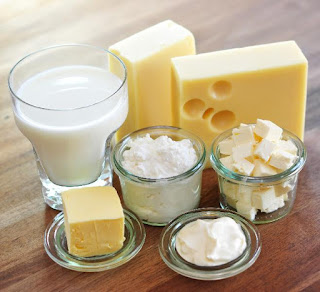What are the Composition of Milk ? || Milk & Milk Products
MILK & MILK PRODUCTS
Composition of Milk :
• Milk Fat :The flavour of milk is due to milk fat. The lipid portion includes both phospholipids and triglycerides. Others liquid materials present in milk are sterols, free fatty acids, Carotenoids and fat soluble vitamins. Carotenes are responsible for the yellow colour of milk fat.
• Milk Proteins :
a. Casein : Casein institutes 80% of the total nitrogen in milk. The remaining whey protein constitutes lactoglobulin and lactoalbumin.
b. Whey Proteins : Whey protein made up of alpha-lactoalbumin and beta-lactoglobulin, serum albumin, the immunoglobulins, enzymes and proteus - peptones.
• Milk Sugar :
Milk contains 4% to 5% carbohydrate. The chief carbohydrate present in milk is lactose, a disaccharide, although trace amounts of glucose, galactose and other sugars are also presents.
• Salt :
Chlorides, phosphates, citrates, sulphates and bicarbonates of sodium, potassium, Calcium and magnesium are present. Copper and iron are important in the development of off flavours in milk and Milk products.
• Enzymes :
Alkaline phosphatase, one type of lipase and xanthin oxidase are present in milk.
• Colour :
Yellowish colour of milk is due to the presence of carotene and riboflavin.
• Flavour & Aroma :
Milk is slightly sweet because of it lactose content. Flavour sensation in mouth is due to fat protein and some of the salts such as calcium phosphate.
The slight Aroma of fresh milk is produced by a number of low molecular weight compounds such as Acetone, Acetaldehyde, Dimethyl Sulphide and short chain fatty acids.
Nutritive Value of Cow's Milk (Per 100 gram)

• Moisture (g) - 87.5
• Energy (kcal) - 67
• Protein (g) - 3.2
• Fat (g) - 4.1
• Carbohydrates (g) - 4.4
• Calcium (mg) - 120
• Phosphorus (mg) - 90
• Iron (mg) - 0.2
• Vitamin A (I.U.) - 174
• Thiamin (mg) - 0.05
• Riboflavin (mg) - 0.19
• Niacin (mg) - 0.1
• Vitamin B12 (ug) - 0.14
Milk Products :
A. NON FERMENTED PRODUCTS
• Skim Milk : skim milk is used for low calorie diets and for children who need high protein.
• Evaporated Milk : This is the milk from which about 50% to 60% of the water has been evaporated.
• Sweetened Condensed Milk : The product is made from pasteurised milk that is concentrated and sweetened with sucrose.
• Dry Milk : Dry milk can be made with whole milk or skimmed milk.
• Khoa : It is used in the preparation of gulab jamun, carrot halwa and coconut burfi.
• Rabri : It is a prepared, concentrated and sweet and product comprising several layers of clotted cream.
• Chhaina : Like cottage Cheese is called paneer.

• Ice cream & Cream
B. FERMENTED MILK PRODUCTS
• Butter, Cheese, Curd, Yogurt, Shrikhand.ROLE OF MILK AND MILK PRODUCTS IN COOKERY
• It contributes to the nutritive value of the diet. e.g, - Milk Shakes, plain milk.• Milk adds taste and flavour to the product. e.g, - Payasam, Tea, Coffee.
• It acts as a thickening agent along with starch. e.g, - white sauce.
• milk is also used in deserts. e.g, - Ice-cream, Puddings.
• Curd is used as a souring agent. e.g, - Rava Dosa.
• Khoa is used as a binding agent. e.g, - carrot halwa.
• Cheese is used as garnishing agent.













Comments
Post a Comment
Please do not enter any spam link in the comment box.